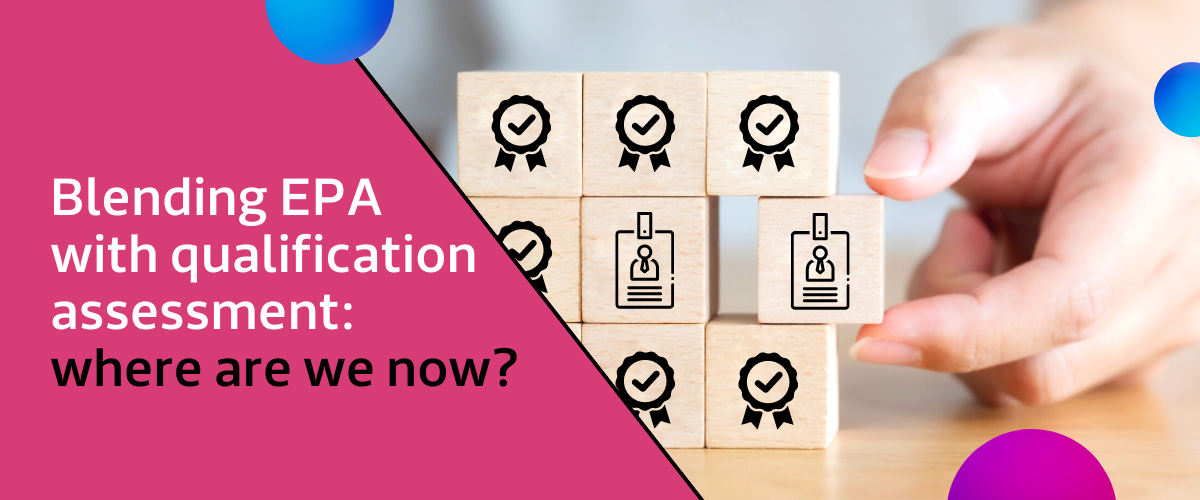Delivering better-qualified apprentices, greater certainty for employers and EPAOs, and overall, increasing the value of apprenticeships. That was the ambition of IfATE’s consultation into blending EPA with qualification assessments earlier this year.
Just this month, we’ve learned that 4 out of 10 apprentices are dropping out of their assessments, costing employers £1.9 billion pounds.
So, is it time for an update?
Consultation? What consultation?
As you will know, in most apprenticeship standards, job-based qualification assessments are separate from apprenticeship EPAs.
However, in some standards, such as adult care worker or marine electrician the qualification assessment (leading to a diploma) is mandatory. This effectively blends the EPA and the ‘mandatory qualification’ assessment into one.
IfATE launched a consultation (open to employers, apprentices, providers and assessment bodies) into extending this mandatory qualification requirement for apprenticeships in December. It wrapped up on February 17th 2023, and we’re still awaiting the results.
Why blend EPA and the qualification assessment in the first place?
IfATE has itself admitted that “qualifications and apprenticeships haven’t always worked together as well as they could.”
This is a gentle way of stating that the current situation isn’t tenable, and IfATE is carrying out this consultation to gauge key stakeholders' appetite for reform.
This proposal to blend mandatory qualifications and EPA looks to resolve three main issues with EPA:
- It will stop learners from being ‘over-assessed (which takes its toll on learners, and stretches both assessors and employers)
- It will make EPA a more ‘valuable’ feature of apprenticeships (leading to an industry-recognised qualification)
- It will reduce the number of apprentices dropping out of programmes.
This final point is vital - particularly in a context where apprentice drop-out rates are approaching half, and 1 in 10 ‘established’ apprenticeships has failed to find a single apprentice.
The elephant in the room is that apprentices will frequently gain a ‘mandatory qualification’, then drop out of the apprenticeship course - which has seriously negative consequences for all parties involved.
IfATE hopes that blending this qualification with EPA will reverse this trend and restore confidence in apprenticeship pathways for employers, apprentices, training providers and EPAOs.
What’s the risk of not doing so?
IfATE has recognised that “the [unblended] arrangement can be good for apprentices - supporting them to achieve occupational licences and other certifications that businesses consider important”.
However, failing to reverse this trend of apprentice drop-out will lead to some of those negative consequences we referred to earlier:
- For apprentices, it reduces their chances of finding gainful work.
- Employers lose a resource - and the levy that they have paid to hire and train apprentices.
- Training providers, EPAOs and government are more likely to stop supporting apprenticeship standards with high drop-out rates.
This drop-out is particularly damaging to more niche apprenticeship standards - many of which are in heritage and highly technical industries where a significant skills gap exists.
However, in all cases, everyone involved would be far less likely to trust the value and viability of apprenticeships (versus other routes, such as university degrees).
What’s next?
The current unblended approach risks making a fallacy of EPA: if EPA isn’t valuable without mandatory qualifications, why take a full apprenticeship in the first place?
The fact remains that if an apprentice drops out during their course, they’ll leave with no record of their skills. As an EPAO, you know that you can’t do anything more to support an apprentice, an employer or a training provider if you don’t have these records.
We developed tools like epaPRO to streamline every part of EPA - from record-keeping to arranging assessments. It’s a one-stop-shop platform that EPAOs can rely on to make the process of EPA more transparent and more efficient: which should give every stakeholder confidence in the learner journey.
We have no doubt that if the blended approach comes to fruition, epaPRO will make managing blended EPA and qualification assessments seamless.
However, until that confirmation comes, we’ll continue to make EPA easier for EPAOs, apprentices, assessors and training providers.
Want to see how epaPRO could work for your EPAO? It’s a revolutionary system that’s designed with your organisation’s specific needs in mind, so you can only do it if you book a demo, and you can ask all the questions that matter to you.
